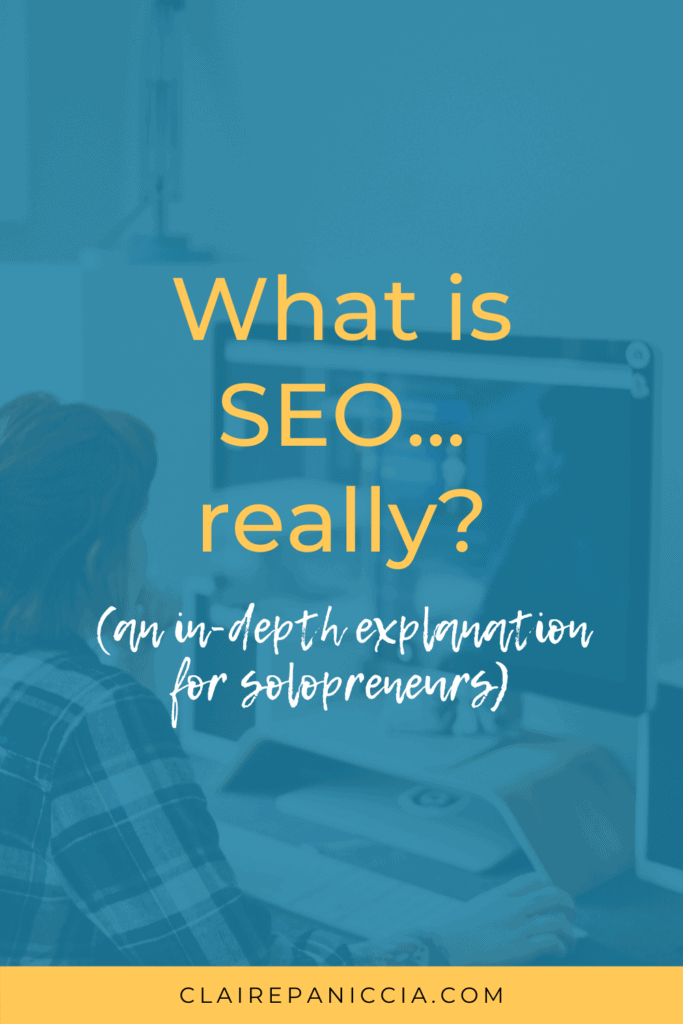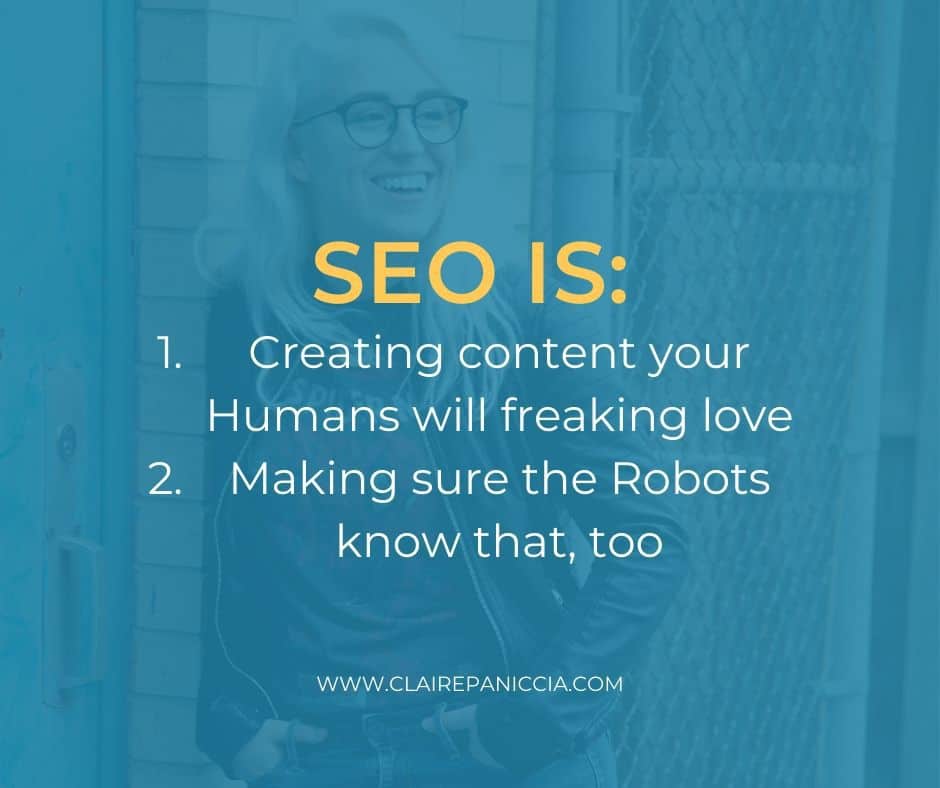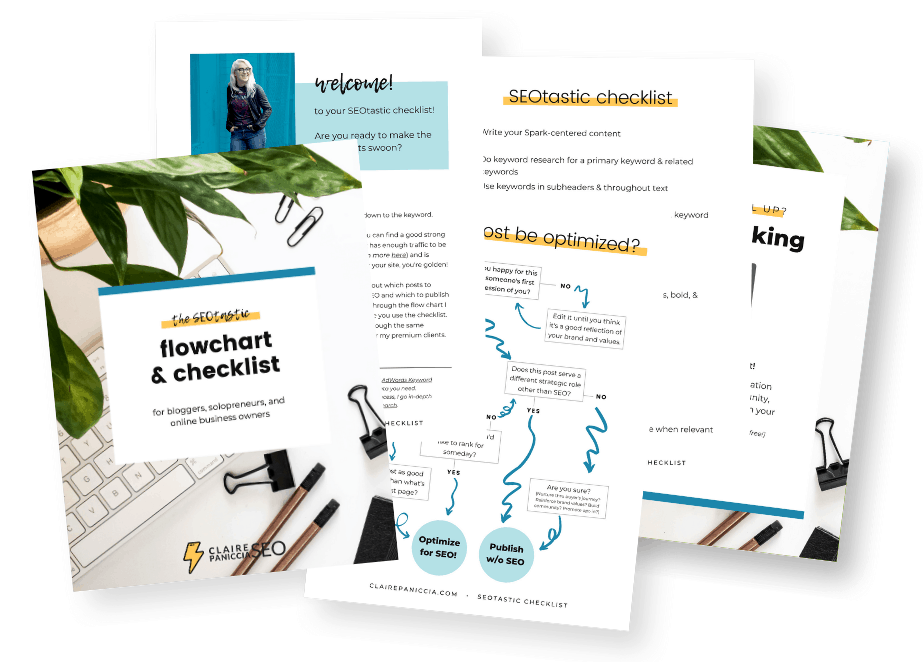There’s a lot of info out there about SEO, and most of it is either vague or confusing or both.

You probably know you need SEO, in the same way you know you should drink 8 glasses of water a day.
You know it’s good for you. You sort of kinda a little bit know why… But you don’t reeeally know why, or how it works, or how to approach getting started with it.
And whenever you try to look into it, it’s all just too overwhelming and confusing.
But it doesn’t have to be.
In this post, I’m going to explain exactly what SEO is in regular human speech (not confusing technical jargon), why you should care as an online solopreneur, and I’ll also give you clear, actionable guidance on what you should really be focusing on to make SEO work for your business.
Why you should care about SEO
Instagram is amazing for community and relationship building
Email is perfect for nurturing people you know are interested in you and your stuff
Podcasts are great to reach people who listen to podcasts (which, not everyone does)
But you know what everyone does?
Google things.
SEO Statistics
- In 2020, the average number of Google searches per day are over 7 billion.
- That’s 81,000 searches per second in 2020, up from 63,000 in 2016. (source 1, source 2)
- The total Google search volume grows by roughly 10%–15% per year. (source)
- An average internet user conducts between 3 and 4 Google searches per day. (source)
- Organic drives 300% more traffic to websites than social media. (source)
And here are two case studies from clients of mine, to show you how SEO can have an impact on the independent online solopreneur.
- Client Case Study: Increased traffic to a blog post by 450% in 24 hours
- Client Case Study: First page of Google and a reference from Wikipedia
What SEO really is at its core
If you walk away from this post with only one nugget of knowledge, this is what I want it to be:
Search engines (like Google, but not just Google) are all about giving their searchers the best possible results for their searches.
That’s it.
That’s all they care about.
That’s what the super complex top secret algorithm is all about. A super sophisticated way of determining what the best results are that a human searcher is looking for.
So, if you take that logic one step further:
In order to make the Google Robots love us, we need to create the best possible ever thing that our Humans are looking for.
Google wants what Humans want.
So create something that Humans want.
More specifically
- create something that your Humans want,
- make the experience as amazing as possible,
- and make sure the Robots can understand how amazing it is.
That’s it.
That’s what SEO is really about.
Once you understand that, it becomes much easier to figure out what steps to take when.

What is SEO, literally?
SEO is an interesting thing.
It stands for Search Engine Optimization, referring to all the things you do to help your site show up in search results for terms that your people are searching for.
But before we get into how to do it, let’s talk about how it works.
How SEO works
I like to think of the algorithm as a giant swarm of Robots (way more fun)
So the search engine process is this:
- Human types something into the search bar (essentially asking the Robot swarm a question)
- Robots scan the whole internet looking for the best possible content in response to what they think the Human is asking
- Robots come back with a handful of web pages and say “Here, this is the best ever of what we think you’re looking for”
- Human scans through and clicks through one or two of them
Our goal with SEO is to be in that handful.
What it looks like to “do SEO”
Here’s the thing:
SEO isn’t one thing that you do. It’s not a box to check.
SEO overlaps with multiple different aspects of your website and online marketing.
- There’s aspects of your website development and setup that need to be optimized for SEO.
- Parts of your copy will need to be SEO optimized.
- When you upload images to your site, they need to be optimized too.
- And of course your content. You need to have optimized content, like blog posts and articles, that target strong keywords that your site can rank for on Google.
And that’s just the tip of the iceberg.
I like to think of SEO as pie.
(Weird, I know, but stick with me)
Think of digital marketing as a table at a party covered in a whole bunch of different kinds of pies.
The Social Media Marketing pie is over there, and the Email Marketing pie is over here, and the Content Marketing/Blogging pie is next to that, and the Facebook Ads pie is over there, and the PR pie is over there, and the Web Design pie is right next to the Web Development pie…..
You get the idea.
Well, the SEO pie isn’t really it’s own pie.
It’s a pie pan filled with slices from a whole bunch of different other pies.
It’s got a slice of Content Marketing pie, and slices of Web Design and Web Development pie, and a slice of PR pie (yes, really!), and a tiny wedge of Social Media pie, and then a big scoop of miscellaneous Google-algorithm ice cream on top, melting and oozing between the slices and mixing in with the fillings…
So basically, getting traffic from search engines isn’t just “SEO-ing”.
It’s about doing lots of different digital marketing things, all in an SEOtastic way.
All so you can appeal to the swarms of Google Robots scanning the whole internet looking for the best ever pages to show a person who just searched “website design for dentists” (or whatever keyword it is you want to show up for).
So… if SEO is all those things… how do we know what to do or where to start?
The 3 Main Elements of SEO
Almost everything you can do to optimize your SEO serves at least one of 3 purposes:
- User Experience
- Authority
- Communicating with the Robots
This is great, but not as useful as a different set of 3. The 3 main elements of SEO.
These are the three main types of tasks you’ll be doing to optimize your business for SEO, the ones that have the biggest impact on your results in the long run.
- SEO Content
- Technical SEO
- Backlinks and EAT
We won’t be going super in depth on these in this guide, but here’s a quick overview of each one.
SEO Content
Content is the most important part of your SEO strategy.
These are the blog posts, articles, podcast transcripts, infographics, etc that will be showing up in search results. You’ll be optimizing each piece of content to target a specific keyword (or set of keywords), aiming to show up in search results and draw in traffic from the people searching for that keyword.
So this encompasses not just the creation of the content, but also the keyword research, the optimization of the content for the keyword, optimizing the on-page experience for both Robot-comprehension and user experience.
Technical SEO
Technical SEO is mostly about setting up the foundations of your site to be Robot-friendly and also to be a positive user-experience.
A very large part of Technical SEO is focused on pagespeed optimization (making your site as fast as you can) so that people don’t hit the back button.
But it’s also about making sure the search engine’s Robots can access, scan, and understand all the pages on your site that you want it to.
| Related Posts: What’s the best SEO plugin for WordPress? My honest (controversial) answer 9 Easy Mistakes You’re Making on WordPress That Are Killing Your SEO |
Backlinks and EAT
Backlinks and EAT are both part of a very important, but less controllable aspect of SEO.
These are both considered “off-site SEO”, aspects of your SEO that are almost completely out of your control. I tend to categorise these in the PR slice of the SEO pie.
Backlinks are links to your site from other sites. They are an indicator of authority in the eyes of search engines. Like votes of confidence from other websites.
But you don’t just want any old backlink. You really want backlinks from relevant sites in your industry or niche, particularly ones with higher perceived authority than yours.
EAT is an acronym, standing for “Expertise. Authoritativeness. Trustworthiness.”
Of these two off-site SEO elements, this one is the least tangible (you can count backlinks and measure them, but you can’t measure EAT).
But depending on your niche or industry, it could be extremely important.
It became an important factor in the Medic update of 2018, and has been refined and updated multiple times since then in other various updates.
EAT mostly impacts sites that Google calls YMYL (Your Money, Your Life): sites about money, health, and other industries that, given bad info, could have a detrimental effect on readers’ lives.
| (If you want a deep-dive on EAT, check out this article from Ahrefs, my SEO tool of choice) |
Different types of sites and businesses need to approach SEO differently
Now, before you go off and start tackling those 3 elements head-on, there’s something important for you to know.
Different types of sites and businesses need to approach SEO in different ways.
Depending on your business model, your production capacity, your budget, your goals, your industry, where you’re at in your business journey… Depending on all those things, you’ll want to be focusing on different aspects of SEO.
For example:
- Business A is a one-person service-provider who markets as a personal brand and works 1:1 with clients, but also wants to start selling a course soon, and is also the only person wearing all the hats in their business.
- Business B is a startup venture with a full team and venture capital who wants to grow their business fast fast fast so they can turn around and sell it in two to five years.
- Business C is an established, medium-sized manufacturing company currently selling in bulk to retailers like Target and Lowes, but wants to start selling direct to consumer on their own new ecommerce site.
All of these businesses have completely different goals, completely different budgets and resources, completely different business models, and therefore will have completely different SEO strategies.
Business C will probably be most focused on the technical and backlinks, and instead of content, they’ll optimize product pages (which is a whole other ball game).
Business B will probably be focused on content, backlinks, and speed. They’ll hire out their content creation to multiple freelancers to create (probably) boring but optimized content as fast as possible, while simultaneously trying to get backlinks as fast as possible (and possibly not in a very ethical way).
But those of us who are more like Business A?
Us online solopreneurs, with our limited resources, long-term goals, values, passion, and loathing of all things boring?
When it comes to SEO, what moves the needle for us is completely different.
What will actually move the needle on SEO for the online solopreneur business
Stop worrying about WordPress vs Squarespace and which one is better for SEO.
For the online solopreneur, the technical aspect of SEO is NOT what moves the needle.
Sure, yes, have the basics in place. Make sure your site is secure, functional, and isn’t loading at the pace of a snail.
But other than that, don’t stress about technical SEO. You can come back to optimize the tech more when you have more traffic.
Instead, I want you to focus on just one thing: content.
And not just any content. Strategically SEOtastic content.
Create high value long form evergreen content
This is the biggest thing you can do to help your site’s SEO.
Content that succeeds at SEO needs to solve the problem or question that the searcher was looking for as thoroughly as possible. You want to be in-depth in your information, cover all the necessary subtopics, and leave them fully satisfied, so they don’t feel like they have to click the back button and keep looking for what they need.
You also want to make sure the user experience on the page is great. No big intimidating walls of text. Make it skimmable with subheaders and bullet points and short paragraphs. Make it visually interesting with images, graphics, and maybe a formatted quote or two.
You also want to make your SEOtastic content long-form. The average result on the first page of Google is 1,447 words long. I usually suggest 1500 words or more.
To some people, 1,500 words might sound daunting, but trust me. When you’re writing about something in your expertise that you have opinions on, and you’re trying to go as in-depth as you can, it’s not hard to reach or exceed 1500 words.
Do your keyword research and optimize your content accordingly
This is the bit that a lot of people miss.
Sure, you’ve written a spectacular, in-depth, high value piece of content that your ideal people need, and the ones who’ve read it love it.
But.
If it’s not optimized for a keyword that real live humans are typing into real live search bars, no one will ever find it on Google and you won’t get any new traffic from SEO.
Doing your keyword research for your valuable long-form content is the difference between buying all the lumber and supplies to build a house, and then either having a blueprint and plan, or just winging it.
Find a keyword that
- enough people are searching for,
- that your people are searching for,
- that is accessible for a site with your level of perceived authority,
- and matches the “user intent” of your page (eg. people searching for “globe” might be looking for globes of the Earth, but your content is about Shakespeare’s Globe Theatre. That’s mismatched user intent)
Then, once you have that keyword, optimize your totally amazing long-form content for that keyword, and then press Publish.
As a note, not all of your content will need to be optimized for SEO. Sometimes your content will serve a totally different strategic role, and SEO won’t really play a part in it. And that’s okay! The key is to make sure you know which ones to optimize for SEO, and then do it full on.
| Related Posts: What is keyword research? (it has nothing to do with green lights) Stop Choosing Keywords the Wrong Way (do this exercise instead!) |
Have something in place to DO with that traffic
This has nothing to do with SEO, but everything to do with the impact good SEO will have on your business.
If you’re slaying at SEO, bring all the traffic in on your totally amazing SEOtastic piece of content, but there’s nothing on the page that does anything with that traffic, it’s all pretty pointless.
You need to have something to capture the traffic you’re bringing in.
(In the SEO world, this is called Conversion Rate Optimization. I just call it good sense)
- Have a free opt-in related to the content topic embedded in the post so you can grow your email list.
- Pitch your services and have a call-to-action to book a free discovery call or fill out an inquiry form.
- Link to related products within the content.
And if the idea of promoting your email list or products in your high-value free content feels gross to you, here’s a thought for you that might help:
If someone lands on your content, f*cking loves it because it’s so high value, resonates with your message and brand and tone, they want to take action and stay in your orbit. They want to get on your email list. They want to buy your products.
So by embedding an opt-in form, including a call-to-action, and linking to your products related to the content, you’re actually helping them even more.
So there you have it. That’s what SEO really is, how it really works, and what actions you should focus on as an online solopreneur business owner.
It’s really not as complicated or mysterious as all the other free content on the internet might have you believing.
Once you understand that the SEO Robots want what the Humans want, it becomes a whole lot easier to figure out what to focus on.
To help you figure out which blog posts you should optimize for SEO, and which ones to focus on other strategies for, I made this free SEOtastic Flowchart & Checklist.
It walks you through the whole decision-making process, and also has an optimization checklist so you don’t miss a single thing to maximize the SEO power of your SEOtastic content.
Free SEOtastic Flowchart & Checklist

